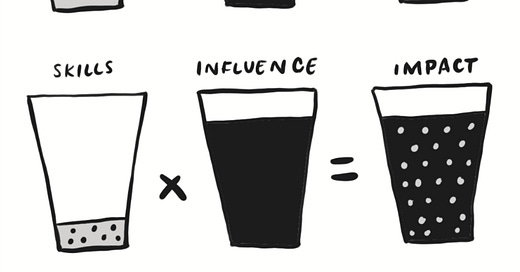We know that many designers feel underutilized at work. We also know that as designers we love to complain and see the flaws all around us. We rant about bad typography on city streets and on restaurant menus. We critique, often with dismay, the confusing UX in the apps and websites we use, and the flaws in our public transportation, school systems and city governments. Yet we rarely ask why is this the state of things? This leads to two questions:
Why aren’t designers better utilized in the world?
What are we doing to change this?
The most dangerous and mistaken answer these questions often lead to is that there is a shortage of design talent (which we define as a combination of knowledge and skill). This is not the problem. Talent is only useful if the person who possesses it has either power or influence. Without power or influence, talent is useless.
Think of all the meetings where your best ideas were ignored. If you were twice or three times as talented as a designer, would it have made any difference? Probably not, since the people you needed to convince lacked the understanding of good design necessary to value your talent. However, if you had twice as much power, you might have been the decision maker, and didn’t need to convince anyone of anything. Or if you had three times as much influence, they would have trusted you even if they didn’t fully understand your ideas.
On the first day of design school, and in the first page of every design book, there should be a clarifying lesson about human nature. Decision making in the real world is a social process, not a solitary one. This means design is usually a social process too and outcomes will be defined more by relationships than ideas alone. We suggest:
Your success as a designer depends equally on your relationships as it does on your design talent. The powerful people you need as allies will likely know little about design and you will have to teach and persuade them. Your amazing ideas and concepts can’t help the world if they are never built by your organization. Your ability to explain your design ideas and convince people to use them is equally as valuable as your creativity.
This means that influence and power are the multipliers of design talent. This explains why someone with low design talent, but great power (like a CEO), can do terrible things, whereas someone with great design talent, but low power, likely has no impact at all.
But for many design purists this is a betrayal. It muddies the meaning of the word design to be more than the crafting of ideas. A purist might say if they wanted a job based on relationships, they’d become project leaders, product managers or entrepreneurs. They chose to be a designer so they could focus on craft.
This is why design is hard. We know the gaps that exist that prevent us from having the impact we want, but our pride gets in the way of closing it ourselves. We’ve become acculturated to waiting for someone else to close it for us, which is unlikely to happen, keeping us stuck in the ego trap.





I love this articulation of a challenge I've encountered too many times. When I think about it, designers I've worked with who have built great relationships with their clients have had their work reach the market more often. They've built a relationship of trust and understanding.
It's not always what we want to hear, but we need to meet our clients, partners, users, and other stakeholders in our design work where they are. What is their appetite for design? Do they value it? What do they value? How can we take ownership of the gaps and influence where they are?
One aspect I have found interesting about this very true depiction is how few designers are curious about this problem of why their words/work go unheeded. I have seen more than a few designers (myself included) have a project get derailed by a 'surprise' stakeholder, and rather than learning more about the where/why of that stakeholder they think of it as a one-off misunderstanding. If more designers entered an organization with their first task being understanding 'how does this company make things?' they would quickly start to see who else has to be at the table for something to get done...